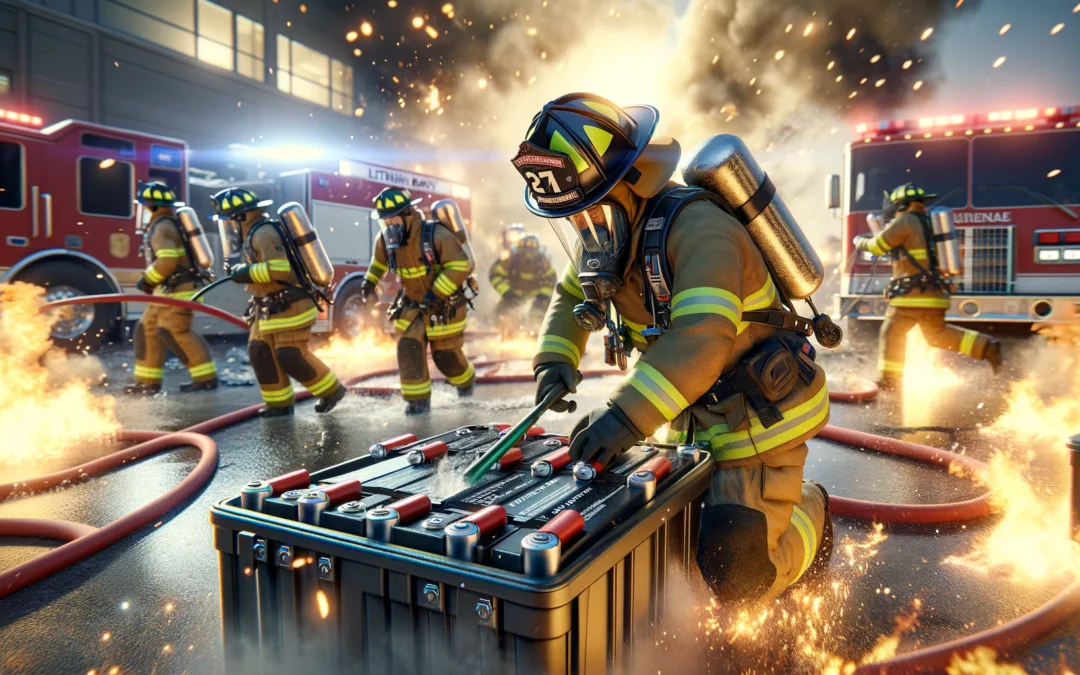Inside a Battery Fire: A Firsthand Look at Hazmat Realities
I sat down with Bobby Salvesen and Mike Monaco to talk about something we don’t discuss nearly enough: the dangers of lithium-ion battery incidents. What unfolded was an honest and practical discussion between two seasoned hazmat pros, full of hard-earned insights that matter for anyone in emergency response.
Bobby shared a call he responded to involving a four-story building where someone was tinkering with repurposed e-bike batteries. The outcome? A full-blown fire. These batteries can go into what’s called thermal runaway – a chemical chain reaction that builds heat, gas, and pressure, ending in violent explosions. And as Mike pointed out, these situations are more common than you’d think.
The Anatomy of a Lithium-Ion Battery Fire
To understand the risks, you have to know what you’re dealing with. These batteries are made up of an anode, a cathode, an electrolyte (usually lithium salts in an organic solvent), and a separator. When damaged, they can leak gases that are not just flammable – they’re toxic. That’s why PPE isn’t just a suggestion; it’s a lifeline.
Mike and Bobby described the difference between two kinds of fires: incineration versus flash fires. A flash fire might sound small, but it’s fast and violent, and often the destruction it causes is disproportionate to how long it burns. Think melted plastics, destroyed property, and airborne chemicals – all in under a minute.
What Responders Need to Watch For
Recognizing a flash fire starts with reading the scene. You’re looking for rapid ignition, possibly with little sustained flame but a whole lot of destruction. If you’re lucky, you’ll see signs early – like battery swelling, unusual odors, or heat spikes. But more often, you get a few seconds’ warning at best.
This is why Mike emphasized air monitoring and masking up. One missed step in PPE, and the consequences could be life-altering. It’s not just about fire; it’s about the cocktail of gases that comes with it.
Overpacking: Not as Simple as It Sounds
The conversation also got technical. Bobby and Mike tackled the subject of overpacking – storing damaged batteries for transport or disposal using containment materials like “cell block.” It’s a good solution on paper, but there are caveats.
Too much battery mass in one drum, and you exceed the energy rating the cell block was designed to handle. That’s a recipe for disaster. Bobby warned responders to calculate energy density carefully and not fall into the trap of “just pack it all in.”
Should We Be Dismantling Battery Compartments?
Another provocative topic was whether responders should dismantle battery packs to prevent a large-scale thermal event. Mike was honest – no one wants to do this unless absolutely necessary. But sometimes, it’s the safest route. Creating a controlled failure, where you induce thermal runaway in a vented, monitored setting, may actually reduce overall risk.
It’s not standard protocol yet, but these are the kinds of practical ideas being floated as incidents involving lithium-ion batteries increase.
Training, Teamwork, and Mental Load
The technical part of hazmat is one thing, but Bobby and Mike didn’t ignore the psychological toll. High-stress situations like these stretch decision-making, test team dynamics, and load the brain. Mike stressed that responders need both scenario-based training and leadership that promotes mental resilience.
They also spoke to the importance of clearly defined roles and communication. In an environment where seconds matter, knowing who’s doing what – and why – can be the difference between control and chaos.
The Regulatory Tightrope
From a compliance perspective, their points raised some eyebrows. A lot of what’s being done in the field right now rides a fine line with OSHA and EPA regulations. For instance, repurposing e-bike batteries in a residential setting violates most local codes and opens up liability for everyone involved.
There are also reporting requirements under EPCRA if these events release hazardous substances above threshold quantities. As Mike noted, if you’re not filing the paperwork, you’re risking more than just fines – you could face criminal charges.
Evolving Best Practices and the Role of Innovation
What came through clearly was the need for the industry to evolve. Whether it’s testing the limits of cell block materials or piloting new containment ideas (like using a crushing mechanism to safely release gases), the HAZMAT community is in innovation mode.
Mike and Bobby invited other responders to join the conversation. They emphasized the importance of sharing lessons learned and collaborating across jurisdictions.
Conclusion: It’s Everyone’s Fight
This isn’t just a battery problem. It’s a systems problem, a training problem, and yes, a leadership problem. The more we talk openly about it, the safer everyone gets. And that’s exactly why this podcast episode matters.
If your team has seen something similar, or you’re trying out new methods, Bobby and Mike want to hear from you. Let’s move the needle together.


